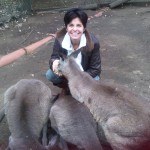SYDNEY, Australia – October 29, 2010
- At October 29, 2010
- By Jessica
- In News
 0
0
There is The Sanctuary in Sydney, run and owned by the same family who founded it in the 1930s, where animals indigenous to Australia live and roam free. Many are animals that were found as orphans, or hurt, or thrown over the fences by people who had them as pets and couldn’t handle them. There are lots of Cockatoos that are actually willed to The Sanctuary since Cockatoos can live to be over 100 years old and often survive their owners.
Well…they had to evict me from this sanctuary because I was fascinated and enthralled by how close I could get to these beautiful animals. See the pictures attached, if you’re interested, and read below for some really interesting, albeit at times repulsive, but always amazing, factoids about how nature runs its course.


There is a strong movement among naturalists here to stop people from calling Koalas “bears.” They bear (pun intended) no relation to the bear family but are marsupials like Kangaroos and Wallabies (more pics attached). Koalas have no natural predators (although they can be attacked and killed by snakes). The reason for this is that Koalas are actually toxic to other animals because the eucalyptus leaves they ingest as their sole sustenance are toxic. Eucalyptus contains cyanide, which poisons any creature that in turn eats a Koala. So you may be wondering how baby Koalas become immune to a toxin like cyanide (or maybe you aren’t but I was so I’m going to share). During the 12 months or so that a baby is separating from its mother, it actually eats the mother’s feces – and its digested cyanide – to develop the required immunity to the toxic eucalyptus it will live on as a mature animal. You may also be wondering, or not, why the world isn’t overrun with Koalas if the species has no natural predators. All species need culling to keep down the numbers, so Koalas are particularly susceptible to Chlamydia YES the STD Chlamydia, for which there is no cure in Koalas. It’s a big problem here in Australia (some people call it Koala AIDS) and it picks off the weakest of the species.) Koalas sleep 18-20 hours a day but a very hungry male named Shawn was awake and ate eucalyptus from my hands. You haven’t lived until a Koala eats from your hand while you stroke its back. Koala fur is as soft as Chinchilla and they used to be hunted for their fur before they became a protected species.
If you’re ever depressed, try to find a field of Kangaroos and watch them hop. They look as though they are skipping rope. They are a wonder to behold, with long eyelashes and gentle dispositions (I’m sure they’re wilder in the bush but so tame and lovely at The Sanctuary). The little joeys in the pouches are hilarious – sometimes a head pops out, sometimes a foot, giving the mother a look of sporting an extra limb. Like humans, Kangaroos can be impregnated all year long. They do not have a season as many animals do. The gestation period is 35 days but the baby stays in the pouch for another twelve months. Often, the mother Kangaroo is nursing one baby in the pouch and one outside. What is truly amazing is that the mother has two different nipples, one dedicated to each offspring, producing two different milks! All at the SAME TIME! Another astonishing fact is that if the environment is not conducive to survival, such as a severe drought, the mother Kangaroo can postpone giving birth to the baby she is carrying for up to two years! Nature never ceases to amaze me with its ability to adapt.



